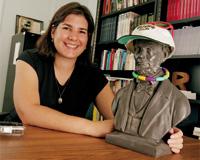

In Anne Rubin’s office sits a plaster bust of Abraham Lincoln, sporting sunglasses, a plastic bead necklace, and a UMBC cap on his head. The bust, a congratulatory gift from one of her students, is a humorous reminder of an extraordinary accomplishment: This winter Rubin, an assistant professor of history in her first year on the UMBC faculty, was awarded one of the most prestigious prizes in her field, the Lincoln Prize, for scholarly work in Civil War-era history.
Lincoln’s hip attire is also appropriate, as Rubin’s work, Valley of the Shadow: The Eve of War, an innovative website and CD-ROM, won the first-ever e-Lincoln Prize, honoring scholarly work in new media.
Valley of the Shadow is a richly detailed portrait of antebellum life in two rural communities, one in Pennsylvania, the other in Virginia. Rubin joined the project’s staff while a graduate student at the University of Virginia. The original concept of the project, begun by Rubin’s advisor Edward Ayers in the early 1990s, was to produce a traditional scholarly book, but “this is a case where technology caught up with what we wanted to do,” explains Rubin. Combining the power and flexibility of the new digital formats with the depth and detail of primary documents, Valley of the Shadow brings the communities vividly to life, and allows visitors to work with the historian’s tools, including a trove of original letters, diaries, census data, business and military records, even newspaper articles and contemporary music.
As project manager for several years, Rubin supervised the staff’s digging for historical nuggets in the field (tucked away in libraries, tiny historical societies, and house attics) and then oversaw the translation of these documents into digital format. To view the website, visit valley.vcdh.virginia.edu.
